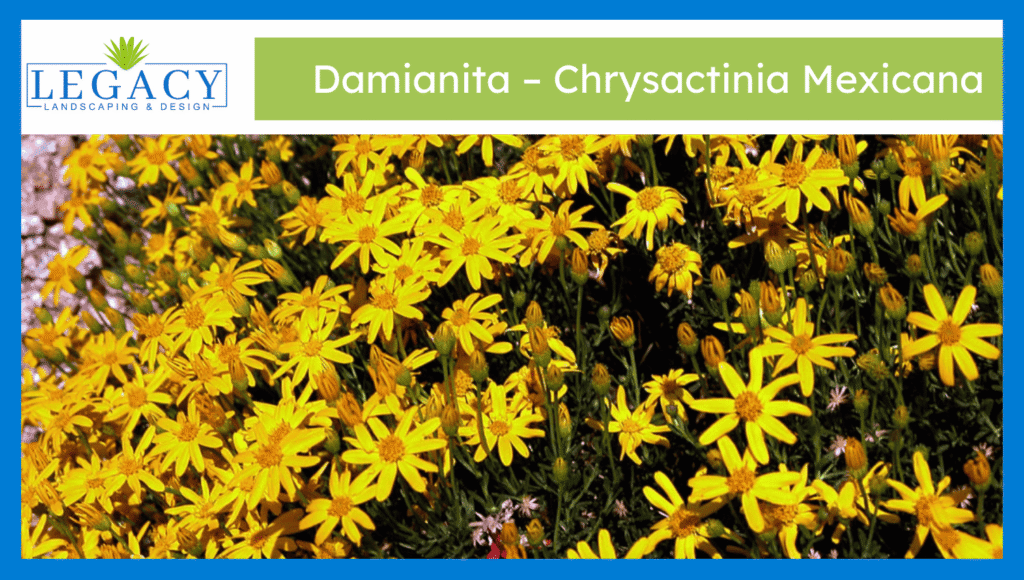Damianita (Chrysactinia mexicana) is a small evergreen shrub native to Texas and northern Mexico. The shrub maintains a thick shape, which grows to heights between 1 to 2 feet. This plant shows aromatic, needle-like green leaves and yellow daisy-like flowers that are noticeable to the eye. During springtime and following summer rains, Damianita produces large amounts of blossoms. Damianita grows under complete sunlight exposure across various poor soil conditions, along with rocky areas. The plant shows excellent drought tolerance, together with deer resistance, thus making it excellent for water-efficient gardening. Its thick covering of foliage, together with its cheery blossoms, attracts bees and butterflies to visit. Damianita’s tough, resilient qualities make it a preferred plant choice for hot, dry regions that require little maintenance gardens.
| Characteristic | Description |
| Scientific Name | Fraxinus velutina |
| Common Name | Arizona Ash |
| Size | Typically grows 30 to 50 feet tall and 25 to 40 feet wide with a rounded canopy. |
| Appearance | Deciduous tree with dense, oval canopy; grayish-brown bark and velvety-textured green compound leaves. |
| Spines | No spines; smooth to slightly rough twigs and branches. |
| Flowers | Small, inconspicuous greenish flowers appear in early spring before leaf-out; usually unnoticeable. |
| Fruits | Produces single-winged samaras (seed pods) that are light brown and dispersed by wind in late summer to fall. |
| Root System | Shallow, wide-spreading roots; may become aggressive in irrigated areas or near foundations. |
| Lifespan | Moderate lifespan—typically 30 to 50 years, though may be shorter under stress or poor maintenance. |
| Habitat | Native to riparian areas and arroyos in the Southwestern U.S. and Northern Mexico; thrives with moisture. |
| Water Storage | No specialized water storage; prefers regular watering, especially in dry climates. |
| Growth Rate | Fast-growing, especially when young; can gain several feet per year under good conditions. |
| Flowering Time | Blooms in early spring (February to March) before leaves emerge. |
| Reproduction | Reproduces via wind-dispersed samaras; self-seeds readily in favorable conditions. |
Table of Contents
Does Damianita Daisy Need Regular Watering in Phoenix?
Damianita daisy requires little watering following its establishment in Phoenix soil. This plant finds success growing in arid and rocky soil conditions, which also make it resilient against dry conditions. The plant becomes harmed when exposed to excessive watering since it develops root rot. Proper deep but infrequent watering allows this plant to stay healthy regardless of drought conditions while keeping its natural drought-tolerant characteristics intact.
How Much to Water a Newly Transplanted Damianita in Mesa, AZ?
A newly transplanted damianita in Mesa, AZ, requires deep watering twice per week throughout its first month of establishment. Root rot becomes a risk for the plant when the soil remains dry for a short period before subsequent watering. The watering schedule requires a reduction in frequency after the initial month. Early development of tough root bases helps the plant develop better drought resistance, which enhances its overall health performance.
How Large Do Damianita Shrubs Get at Maturity?
When the fully matured Damianita shrubs grow to a height between 1 to 2 feet and spread their foliage across 2 to 3 feet in diameter. These plants develop into dense, mounded growth, which produces bright yellow blossoms that emanate from their compact structure. Their tidy growth pattern makes them suitable for rocky garden settings as well as borders and low-attention landscapes.
How Long Does it Take for Damianita to Reach Full Size?
Damianita reaches its full mature size when planted under optimal conditions within two to three years. Healthy plants growing through their growth cycle reach their peak growth rate during warm seasons under conditions of full sunlight and properly draining soil. The plant matures naturally into a compact form through watering sparingly and avoiding excessive fertiliser applications.
Is Damianita a Sturdy Plant? (Drought/heat tolerance, hardiness)
Yes, Damianita is extremely sturdy. The plant stays healthy through extreme heat, together with extended dry seasons and nutrient-poor rocky conditions, without requiring much maintenance. The plant shows high resistance against extreme environmental situations, which makes it ideal for desert gardens and xeriscapes. Its undesirability to deer consumption further strengthens its reputation as a tough plant in challenging environments.
When Does Damianita Bloom?
The flower production of Damianita reaches its peak during spring, but it reflowers following rainy summer conditions. Flowers of daisy shapes in bright yellow colours are distributed throughout the entire shrub to produce vibrant displays. The plant displays random flowering patterns across warm seasons whenever circumstances are appropriate for growth. The combination of proper soil drainage and natural sunlight, along with seasonal water amounts, determines when damianita will flower.
About The Author
Isaiah Espinoza
Isaiah Espinoza is the proud company owner, founder and driving force behind Legacy Landscaping and Design. Isaiah established Legacy Landscaping & Design in 2014, bringing his vision of creating stunning outdoor spaces to life. Isaiah, the founder of Legacy Landscaping & Design, has a deep-rooted passion for construction and design, stemming from four generations of family expertise in the industry. With a KB-1 General Building License and a CR-21 Hardscaping and Irrigation License, Isaiah has spent the past decade transforming outdoor spaces with exceptional craftsmanship and innovative design.

